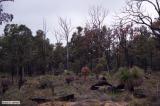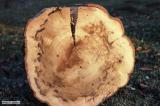Disease
P. cinnamomi was first described in Sumatra in 1922 as the cause of stripe canker on the cinnamon tree, and the islands of SE Asia are still considered to be the likely geographic origin of the species. This is currently the most important Phytophthora pathogen of forest trees, but is also destructive in woody ornamentals, especially rhododendrons and other Ericaceae, and orchard crops including avocado. It was spread worldwide, starting in the era of plant exploration and sailing ships. It is now widespread and continues to be destructive in forests of Australia, Mediterranean countries, Mexico and the SE United States, and is of increasing concern in forests and wildlands of western North America. The host range of P. cinnamomi includes more than 1,000 species (Erwin and Ribeiro, 1996).
Although P. cinnamomi causes disease in many forests and native plant communities worldwide, the largest disease impact is in Australia where it has caused extensive destruction of native forests and heathlands in areas subject to a Mediterranean type climate (Weste and Marks 1987; Zentmeyer 1980). In southern Western Australia, one of the most biological diverse plant communities globally, more than 40% of the native plant species are susceptible to Phytophthora dieback (Shearer et al. 2004), including jarrah (Eucalyptus marginata), banksias, and grass trees. Similar disease of monocalyptus eucalypts and healthland species are recorded in southeastern Australia (Weste and Marks 1987). This soil-dwelling pathogen causes lethal root and collar rot, preventing uptake of water and nutrients. In Australia, advancing fronts of disease reflected the introduction of the pathogen to susceptible ecosystems. The pathogen spreads slowly through root-to-root contact and more rapidly with water movement. Human activities that move soil, such as road construction, mining, vehicular traffic, and the planting of infested nursery stock exacerbate pathogen spread. Disease management includes restrictions on soil and water movement, and preventive treatment of hosts with phosphite (Dunstan and Hardy 2005). Eucalypt dieback affected sites in Victoria have successfully been regenerated with susceptible eucalypts using a high sowing rate to aid in selection for resistance (Department of Sustainability and Environment 2008).
P. cinnamomi is listed In Australia as a key threat under the Environment Protection and Biodiversity Conservation Act 1999. This requires the Australian Government to prepare and implement a threat abatement plan to mitigate the harm caused by P. cinnamomi to Australian species and ecological communities.
P. cinnamomi was introduced during the 18th century in Europe where it caused chestnut ink disease (Crandall 1950). However because P. cambivora also is responsible for the same disease it is difficult to infer the exact time of introduction of P. cinnamomi in Europe. However, the disease rapidly spread in France and in all chestnut growing areas (Vettraino et al. 2005). It is one of the main reasons for abandonment of several chestnut orchards. More recently, P. cinnamomi was reported, mainly in France, as the agent responsible of ink disease of red oak (Quercus rubra, Robin et al. 1992a, b, c), and as the primary factor of root infection resulting in oak decline and mortality in Spain, Portugal and France (Brasier 1993, Robin et al. 1998, 2001; Gallego et al. 1999).
In the Americas, reports of forest and wildland damage from P. cinnamomi are increasing from western Mexico (Tainter et al. 2000) and from southern (Garbelotto et al. 2006) and central California, including both coastal and Sierra foothills counties. In particular situations it is destructive, causing expanding mortality centers in oak, manzanita, and mixed hardwood stands in California. Isolations from the Pacific Northwest are infrequent (Middleton and Baxter, 1955), but perhaps increasing as well. It has been considered to be too dry in the summer, and too cold in the winter for P. cinnamomi to spread in many western forests (Roth and Kuhlman, 1966), despite the susceptibility of many forest plants, and frequent introduction from horticultural settings. With changing climates, P. cinnamomi is expected to expand its sphere of destruction, particularly in Europe and North America.
P. cinnamomi has the broadest host range of any Phytophthora species. It is especially associated with root diseases of eucalyptus, oaks and chestnuts, pines, and members of the Ericaceae (the heath family,) as well as diverse agricultural crops. Symptoms range from fine root mortality leading to gradual tree decline, to enlarging basal cankers, often with bleeding spots, and tree mortality. The table below includes just a few examples.
| Host Latin Name | Host Common Name | Symptoms | Habitat | Region | |
|---|---|---|---|---|---|
| Abies procera | Noble fir | Canker, Root rot | Christmas trees | USA - Oregon | |
| Abies spp. | Fraser fir | Root rot | Christmas trees | USA - Southeast | |
| Agathis australis | New Zealand kauri | Canker, Root rot | Forest | New Zealand | |
| Arbutus menziesii | Madrone | Canker | Forest | USA - Pacific Northwest | |
| Banksia spp. | Banksia | Collapse | Wildland | Australia - Western | |
| Castanea dentata | American chestnut | Canker, Root rot | Forest, Ornamental Nursery, Plantations | USA - Southeast | |
| Castanea sativa | European chestnut | Canker, Root rot | Forest, Ornamental Nursery, Plantations | Europe | |
| Chamaecyparis lawsoniana | Cypress | Root rot | Forest tree nurseries | USA - Oregon | |
| Eucalyptus marginata | Jarrah | Canker, Root rot | Forest | Australia - Western | |
| Metrosideros polymorpha | Ohia | Decline | Forest | USA - Hawaii | |
| Pinus echinata | Shortleaf pine | Decline | Forest | USA - Southeast | |
| Pinus echinata | Shortleaf pine | Decline | Forest | USA - Southeast | |
| Protea spp. | Protea | Root rot | Wildland | South Africa | |
| Quercus agrifolia | Coast live oak, Oak | Decline | Forest | USA - California | |
| Quercus alba | Oak, White oak | Decline | Forest | USA - Ohio | |
| Quercus engelmannii | Engelmann Oak, Oak | Decline | Forest | USA - California | |
| Quercus glaucoides | Lacey Oak, Oak | Forest | Mexico | ||
| Quercus peduncularis | Oak | Forest | Mexico | ||
| Quercus rubra | Oak, Red oaks | Canker, Root rot | Forest | France, Mexico, USA | |
| Quercus salicifolia | Oak, Willow-leaved oak | Forest | Mexico | ||
| Quercus suber | Cork oak, Oak | Canker, Root rot | Agricultural setting, Forest tree nurseries, Plantations | France, Portugal, Spain | |
| Xanthorrhoea spp. | Grass tree | Decline | Wildland | Australia - Victoria, Australia - Western |




